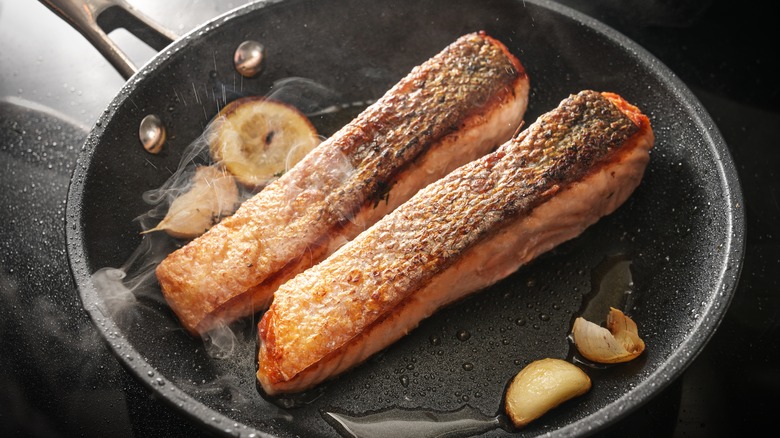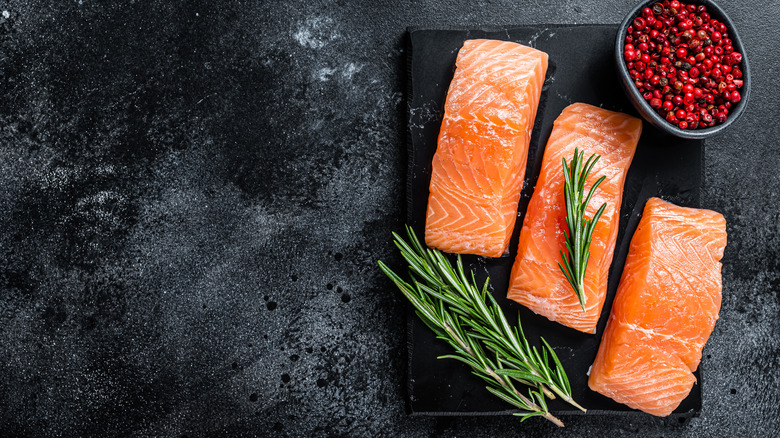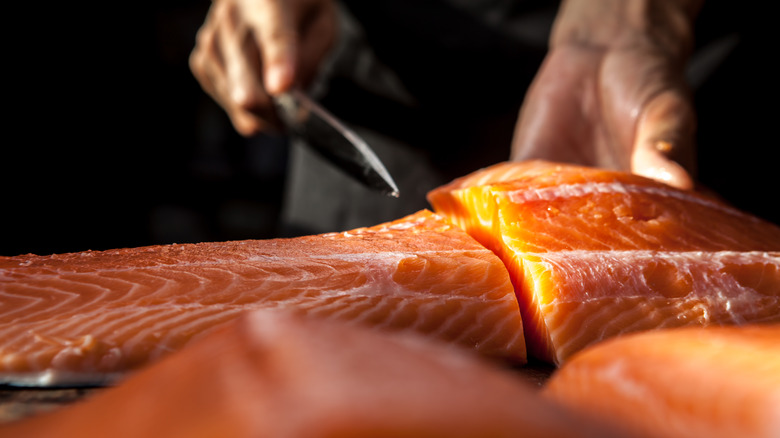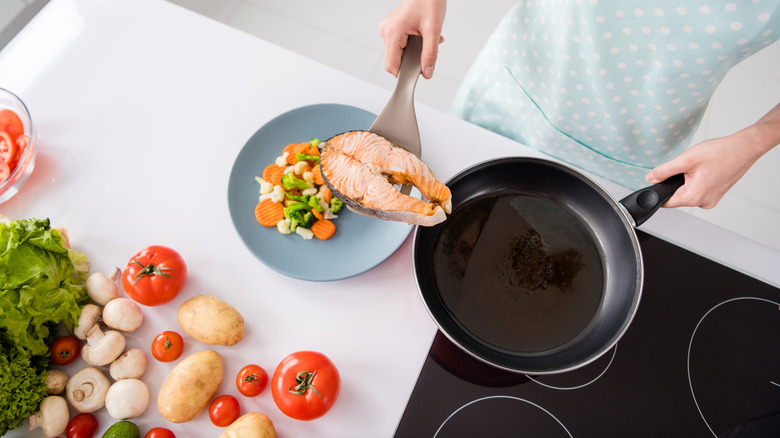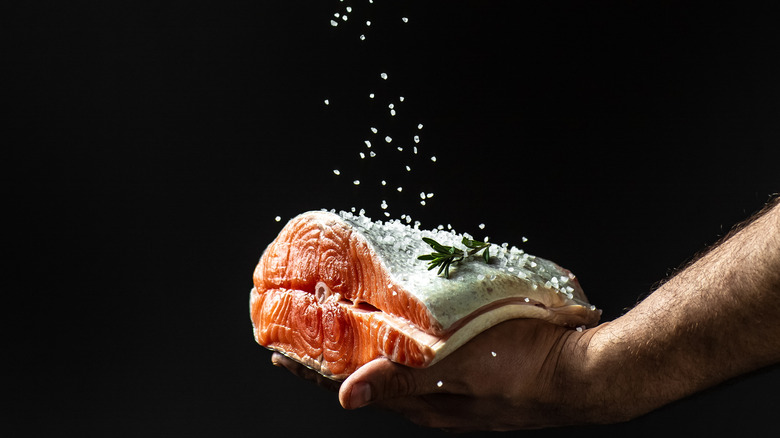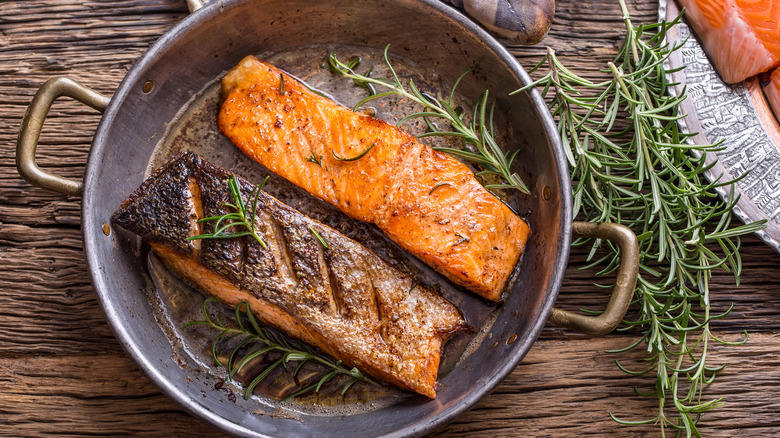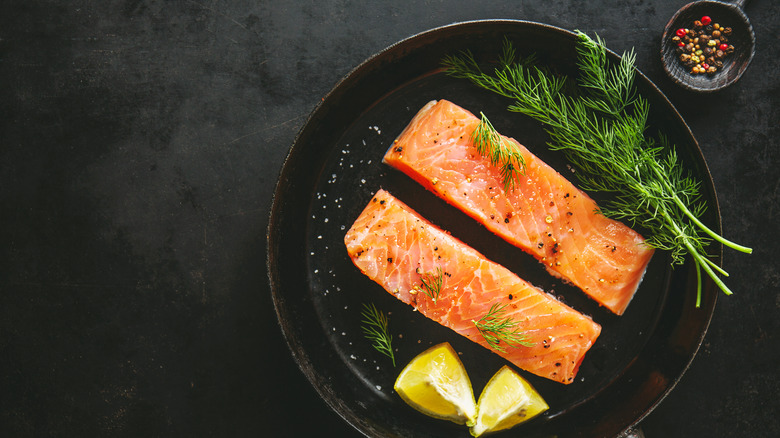Simple Tips For Getting Extra-Crispy Skin On Salmon
Sometimes, salmon skin can be a real turn-off. When not prepared properly, it can be flimsy, lifeless, and even rubbery, making it no wonder so many people have avoided eating it for so long. However, with a little care, you can have delectable, crispy skin that you will be sure to enjoy.
Besides being delicious, there are some great benefits to eating the skin on your salmon. According to Healthline, the skin possesses the most omega-3 fatty acids on the whole fish. These fatty acids are not naturally produced by the body and have been shown to reduce triglycerides and lower the risk of heart disease (via Mayo Clinic).
Another reason why you should keep the skin on salmon is that it helps protect the fish from overcooking. Your fillets will cook more evenly and stay moist and tender allowing the fish to truly shine. Next time you cook salmon, leave the skin on and try following these guidelines to ensure you will get that extra-crispy skin.
Bring salmon to room temperature
One mistake everyone makes when cooking salmon is searing the fillets straight from the fridge. When you cook a really cold piece of fish, like salmon, you are likely to overcook the outside before the center is done. This can lead to drying out the fish or even burning the skin if you have to leave it on the heat for too long.
To cook your fish more evenly, bring salmon to room temperature before you begin. This allows for a more even distribution of heat, keeping the fish tender throughout. City Fish Market recommends letting salmon sit out at room temperature for 15 to 20 minutes. Leaving fish out for too long runs the risk of it becoming unsafe to eat. The FDA advises to not leave seafood out of the fridge for more than 2 hours total, or 1 hour in temperatures above 90 F.
Dry salmon fillets
One of the best tips you need when cooking fish is to make sure you dry the fillets well, especially for skin-on salmon. Moisture does not make for crispy skin. When wet fillets hit the pan, they will release that water and essentially start steaming the fish, which can leave the skin soggy and unable to crisp. Drying salmon fillets can also help prevent the skin from sticking, which is even more of a concern when grilling.
You can dry salmon fillets by scraping the skin back and forth with your knife (like windshield wipers or sharpening a knife) to remove as much moisture as possible. Then, pat the fillets dry with paper towels for extra security. Excess moisture can also lead to your fish getting mushy, so whether or not you are cooking salmon (or any other fish) with the skin-on, it is always a good idea to pat the fillets dry.
Pre-heat the pan
Pan-frying is a sure fire way to get an irresistibly crispy skin on your salmon, but keep in mind how you approach this process. Another tip for cooking fish is to preheat your sauté pan. Reluctant Gourmet explains that proteins denature (chemically unravel) when they hit the hot pan. When they slowly break down from low heat, the protein sticks to the pan. You can mangle or completely destroy the prized skin on your fillets this way. To prevent such a disaster, your pan needs to be hot enough so the protein strands cook quickly and are less likely to stick.
Set your burner to medium to high heat, then allow the pan to preheat until a few drops of water immediately evaporate upon touching the surface — that's how you will know it is hot enough. For cooking fish with the skin on, we recommend using a cast iron or blue steel pan for best results. Nonstick pans, such as Teflon-coated pans, can prevent the skin from crisping.
Cook salmon with oil and salt
Oil and salt are your friend when it comes to searing skin-on salmon. Just like with our recipe for pan-seared black cod, we recommend using a good amount of oil when pan-frying salmon. The oil helps the skin crisp up without sticking. For perfectly cooked salmon, we recommend using a neutral oil. You also want avoid frying with olive oil and other oils with low smoke points. Canola, corn, vegetable, or avocado are ideal for pan-searing fish, as the high heat can ruin other oils by turning them rancid, especially in the case of extra virgin olive oil.
Salt, on the other hand, can help dehydrate fish skin before it hits the pan. Be careful, however, to avoid salting the flesh of the fish until just before cooking. While salt can greatly enhance the flavor of salmon, it can also dry out the fish too much or even start to cure it.
Don't overcrowd the pan
Picking a pan size is one of the most important decisions in cooking. Have you ever started sautéing ingredients in a pan only to realize you need a bigger surface? This is more than about whether the food fits into the sauté pan. You want to avoid overcrowding.
When you put too much in a pan (where your items touch or even overlap) all the excess moisture will release and since it doesn't have room to escape, your food will begin to steam. When it comes to getting a crispy skin on salmon, steam is not a goal. It will prevent the Maillard Reaction from occurring, which is the chemical reaction that causes browning and development of flavor (via End of the Fork).
Culinary Lore recommends only searing one to two fillets at a time in a high-quality pan. If you have a large pan, you may be able to fit more, but make sure there is plenty of room in between each salmon fillet.
Always cook skin-side down
To perfectly cook salmon, we recommend searing skin-side down the whole time. The skin helps act as a heat shield, and the fish will cook more evenly. You can also prevent too much of that white albumin from leaking out of the flesh side. While completely harmless, this tampers the appearance of your salmon. You want a beautiful looking fillet, and this substance will impact the presentation of your final dish.
Once you drop the fillet skin-side down in the pan, gently press the fillet with your spatula for 30 seconds to prevent the skin from curling. Then, leave it alone. People often mess up salmon by touching it too much. This can cause the fish to fall apart during cooking. Instead, let it sit and cook almost completely on the skin-side, 6 to 8 minutes, depending on size. Only flip the fillet over for 10 to 15 seconds to make sure the surface of the other side cooks through.
